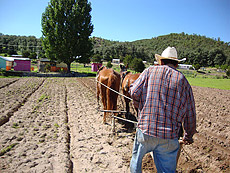The project
2010 study:
The overall objective of the study is to identify genetic and environmental factors and their interactions associated with the development of obesity and type 2 diabetes mellitus (T2DM). In this fifteen-year follow-up study researchers are measuring the prevalence of obesity and T2DM of Mexican Pima Indians and non-Pima Mexicans previously studied. This study also incorporates additional research areas to investigate lifestyle, ecological environment and community perspective changes that have taken place in the region including in the past fifteen years. The communities studied live in and around the town of Maycoba, nestled in the Sierra Madre Mountains of Sonora, Mexico (see maps).
 Subsistance farming.
Subsistance farming.
Since the initial study in 1995 many environmental factors have changed that have contributed to a shift from a more traditional lifestyle, to include more ‘westernized’ elements. Electrical supply to the region is prevalent allowing access to television, and certain household appliances. A project to bring running water to individual homes has recently been completed. The national highway, carretera 16 that runs right through these communities was open to the public when the 1995 study began and has remained well used and maintained. Cars and other mechanized devices have increased significantly affecting energy expenditure. There has also been an increase in number of food stores including a wide range of variety and abundance of processed foods also influencing dietary choices. However the impact of these changes has not been systematically examined.
 Partial view of Maycoba.
Partial view of Maycoba.
This follow up study includes a census of the community. One objective is to compare the prevalence of T2DM and obesity in Mexican Pimas and non-Pimas using similar measures to the 1995 study including height, weight, waist circumference, body composition, oral glucose tolerance and HbA1c. Another objective is to compare current diet, physical activity and total energy expenditure of Mexican Pimas and non-Pimas using the same procedures as the 1995 study. Next, the intersection between genetic and environmental variables will be investigated by documenting the frequencies of T2DM and obesity-associated genetic variants in Mexican Pimas compared to US Pima and non-Pima Mexicans. Finally environmental change, broadly conceived is being investigated including changes in health and environmental perspectives, self-assessed general changes in environment and activity, and land use and land cover change.
1995 study:
A cross-sectional study was conducted to identify effects of traditional and western environments on prevalence of T2DM and obesity among Pima Indians living in Mexico and the United States. Pimas living in Mexico resided in the remote, mountainous region experienced relatively little change in their traditional lifestyle. A similar number of non-Pima Mexicans live in and around the town of Maycoba. In contrast, U.S. Pimas in Arizona live in a more ‘westernized’ society and are known to have the highest recorded prevalence of diabetes in the world. The study showed that although T2Dm and obesity were more prevalent among Mexican Pimas than non-Pima Mexicans, both groups had a significantly lower prevalence of these disorders than U.S. Pimas. The lifestyle of the Mexican population indicated a dramatically higher level of physical activity and a diet high in fiber and lower in calories derived from fat compared to the U.S. Pimas. The U.S. and Mexican Pimas share a similar gene pool, leading to the conclusion that even if populations are genetically prone to T2DM and obesity, the development of these conditions is determined mostly by environmental factors.
See publication list for more information on 1995 study results.